Indiana is home to a diverse range of bird species throughout the year, but during the wintertime, the state becomes a haven for an array of fascinating winter birds.
As temperatures drop and snow covers the landscape, many bird species migrate from their northern breeding grounds to the more temperate climate of Indiana, seeking food and shelter.
These winter birds bring a splash of color and lively activity to the otherwise quiet and peaceful winter months.
Whether you are an avid birdwatcher or enjoy the beauty of nature, exploring the world of winter birds in Indiana is sure to be a rewarding and enchanting experience.
47 Winter Birds in Indiana
Indiana is home to a diverse range of bird species throughout the year, but during the wintertime, the state becomes a haven for an array of fascinating winter birds.
As temperatures drop and snow covers the landscape, many bird species migrate from their northern breeding grounds to the more temperate climate of Indiana, seeking food and shelter.
Here’s a fun and educational activity for the whole family: 47 Winter Birds in Indiana.
1. House Sparrow
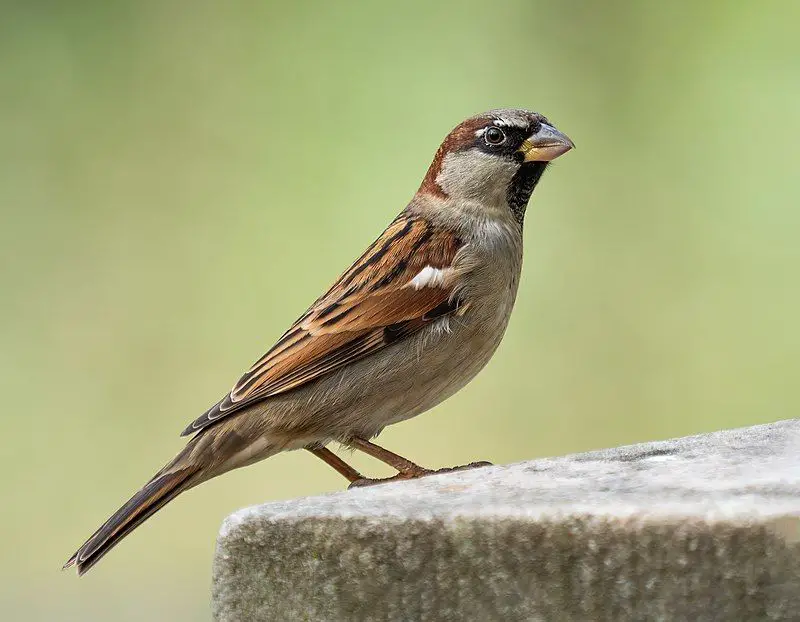
The house sparrow is a type of bird that belongs to the sparrow family called Passeridae. These birds can be found in many different parts of the world. They are pretty small, typically measuring about 16 cm in length.
In terms of weight, they usually range between 24 to 39.5 grams. Regarding their appearance, female and young house sparrows are generally colored in pale shades of brown and grey.
This coloration helps them blend in with their surroundings and provides them with some camouflage. On the other hand, male house sparrows have more vibrant colors.
They display black, white, and brown markings, making them easily distinguishable from the females and young birds. The contrasting colors of the male house sparrows serve various purposes. Firstly, these colors help attract mates during the breeding season.
The brighter markings act as a visual signal to the females, indicating that the male is healthy and capable of providing for offspring.
These markings also play a role in defending territory and establishing dominance among other male sparrows. The house sparrow’s coloration is not only limited to their feathers. They also have distinct beak colors that differ between males and females.
| Kingdom | Animalia |
| Phylum | Chordata |
| Clade | Dinosauria |
| Class | Aves |
| Order | Passeriformes |
| Family | Passeridae |
| Genus | Passer |
| Species | P. domesticus |
2. Red-Bellied Woodpecker
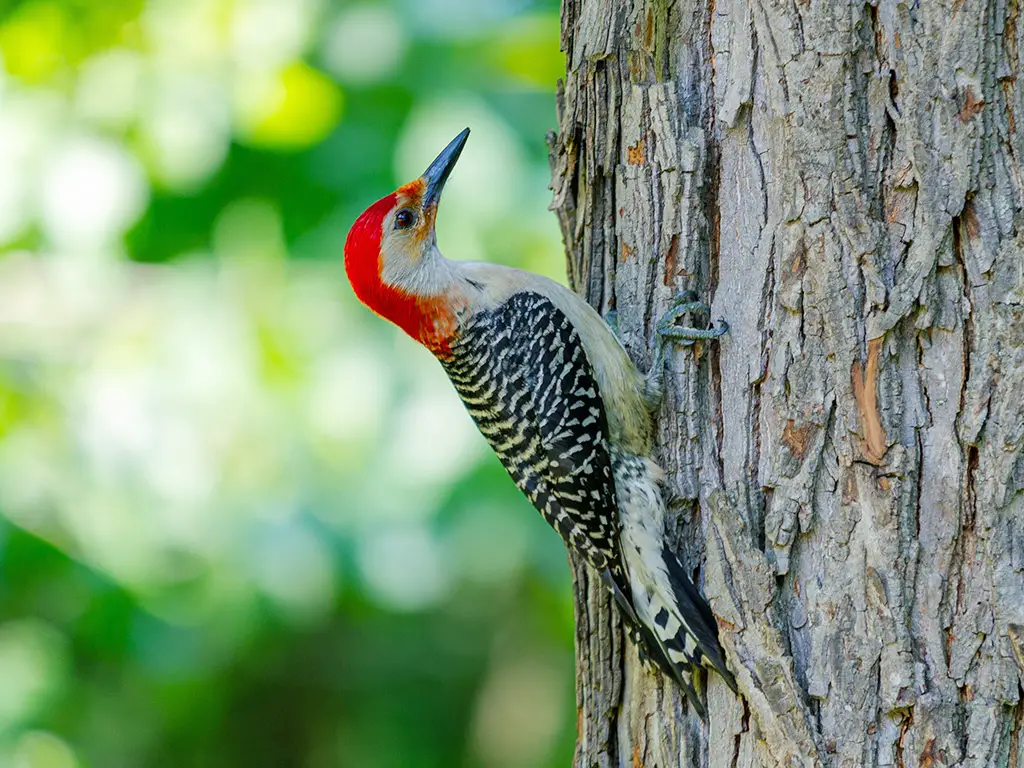
The red-bellied woodpecker is a bird that belongs to the family Picidae. It is not too big or too small; it is considered a medium-sized woodpecker.
This means it is smaller than some other woodpecker species but more significant than others. These woodpeckers are found primarily in the eastern part of the United States. However, they can also be seen in other areas.
They have a wide range, stretching from as far south as Florida to as far north as Canada. This means that they can be found in many different states and provinces within these regions. Regarding their appearance, the red-bellied woodpecker has some distinct features.
As the name suggests, they have a red belly, although this may not be immediately noticeable. Their belly is more of a pale or dull red color compared to other parts of their body.
They also have a red cap on the top of their head, which is more vibrant and noticeable. In addition to their red belly and cap, these woodpeckers have a black and white pattern on their back, wings, and tail.
The black feathers provide a nice contrast against the white feathers, creating a visual.
| Kingdom | Animalia |
| Phylum | Chordata |
| Clade | Dinosauria |
| Class | Aves |
| Order | Piciformes |
| Family | Picidae |
| Genus | Melanerpes |
| Species | M. carolinus |
3. Downy Woodpecker
The downy woodpecker is a type of bird known as a woodpecker. It is the smallest species of woodpecker found in North America. Its size can range from 14 to 18 centimeters. These woodpeckers can be found in various forested areas across the United States and Canada.
However, they are not commonly seen in desert regions in the southwest or the northern tundra. Due to their small size, downy woodpeckers are well-adapted to living in forested environments.
They can navigate through the trees and search for food more quickly than larger woodpecker species. One exciting feature of the downy woodpecker is its ability to drum on trees.
This drumming serves multiple purposes, including communication with other woodpeckers and marking its territory. The diet of the downy woodpecker primarily consists of insects and larvae found within the trees.
They use their strong beaks to peck at the bark and wood, uncovering their prey. These woodpeckers are known for their distinct black and white plumage. They have a white belly and back, with black wings and a black head. This coloration helps them blend in with the tree.
| Kingdom | Animalia |
| Phylum | Chordata |
| Clade | Dinosauria |
| Class | Aves |
| Order | Piciformes |
| Family | Picidae |
| Genus | Dryobates |
| Species | D. pubescens |
4. American Goldfinch
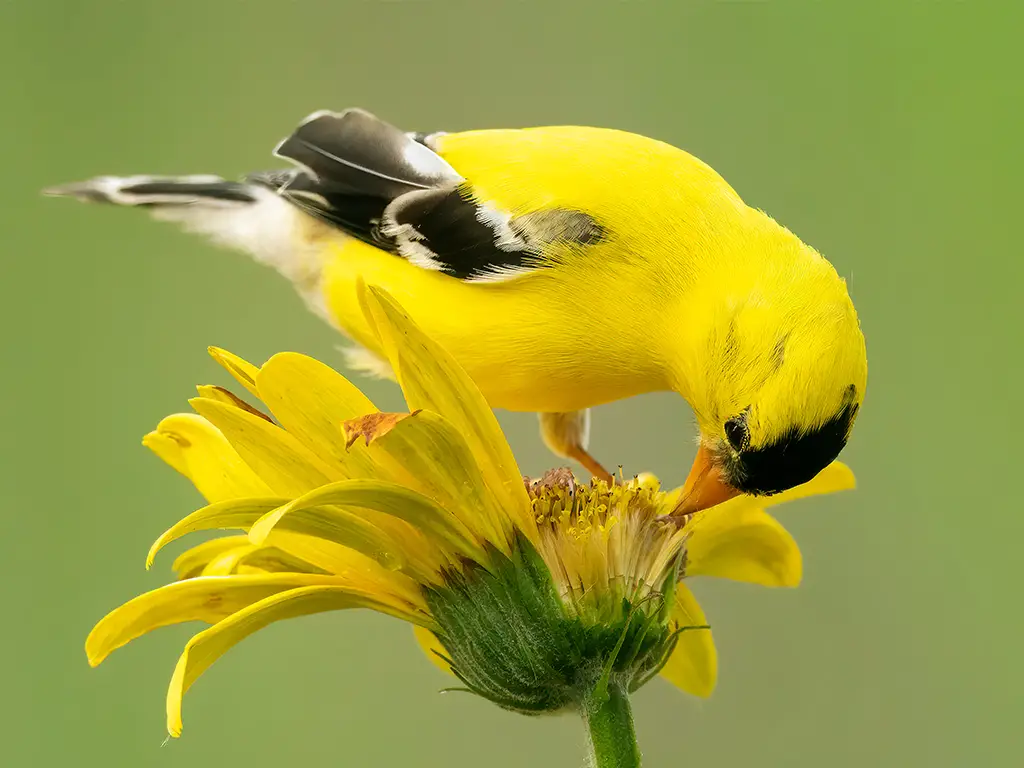
The American goldfinch is a type of bird found in North America.
It belongs to the finch family, a group of small birds known for their colorful feathers and pleasant songs. This bird is migratory, meaning it travels from one place to another depending on the time of year.
During the breeding season, when they mate and lay eggs, the American goldfinch can be found in areas ranging from mid-Alberta in Canada to North Carolina in the United States. When the weather gets colder in the winter, the American goldfinch migrates to a different region.
They move from just south of the Canada–United States border and travel down to Mexico.
This helps them find better conditions for survival as the temperature and food availability change with the seasons. The reason for their migration is mainly related to the availability of food.
During the breeding season, the American goldfinch feeds on insects and seeds from plants like sunflowers and thistles.
These food sources are abundant in the areas where they breed, providing them with the necessary nutrients for reproduction and raising their young. However, these insects and plants may not be readily available in their breeding grounds during the winter.
| Kingdom | Animalia |
| Phylum | Chordata |
| Clade | Dinosauria |
| Class | Aves |
| Order | Passeriformes |
| Family | Fringillidae |
| Genus | Spinus |
| Species | S. tristis |
5. House Finch
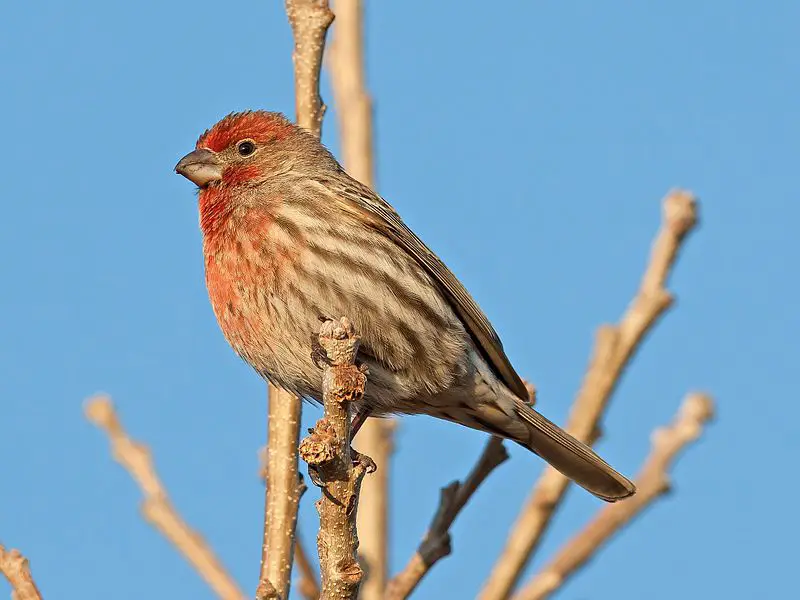
The house finch is a type of bird that belongs to the finch family called Fringillidae. This bird is originally from western North America.
However, it has also been introduced to other parts of the continent, such as the eastern half and Hawaii. The house finch is not the only bird in its genus.
It is grouped with two other American rosefinches, and all three are placed in the genus Haemorhous. The house finch is known for its beautiful red coloration, especially in males. The males have a reddish hue on their heads, chests, and backs.
Females, on the other hand, have more muted colors with brownish feathers. These birds are relatively small, measuring about 12 to 16 centimeters in length. They have short wings and a slightly notched tail.
Their beaks are conical in shape and designed for cracking open seeds, which are their primary food source. House finches are highly adaptable and can be found in various habitats, including urban areas, forests, and grasslands.
They are known for their melodic songs, which they use to communicate and attract mates. Breeding season for these.
| Kingdom | Animalia |
| Phylum | Chordata |
| Clade | Dinosauria |
| Class | Aves |
| Order | Passeriformes |
| Family | Fringillidae |
| Genus | Haemorhous |
| Species | H. mexicanus |
6. Cardinalidae
Cardinalidae is a family of birds found only in the New World. This means that they are native to the Americas and are not found anywhere else in the world. The family comprises different species, including cardinals, grosbeaks, and buntings.
These birds are all part of the same family because they share similar characteristics and traits. Cardinals are perhaps the most well-known members of the Cardinalidae family. They are known for their vibrant red plumage, which is more prominent in males than females.
Cardinals often feed on seeds and insects in backyards and gardens. They have a distinct crest on their heads, which adds to their unique appearance. Grosbeaks are another type of bird that belongs to the Cardinalidae family.
They are named after their large, thick beaks, adapted for cracking open seeds and nuts. Grosbeaks come in various colors, including red, black, and yellow.
They are known for their beautiful songs and can be found in forests and woodlands across the Americas. Buntings are also part of the Cardinalidae family. They are small to medium-sized birds that are known for their colorful plumage.
| Kingdom | Animalia |
| Phylum | Chordata |
| Clade | Dinosauria |
| Class | Aves |
| Order | Passeriformes |
| Family | Cardinalidae |
7. Northern Cardinal
The northern cardinal is a bird commonly referred to by different names, such as redbird, common cardinal, red cardinal, or simply cardinal.
It belongs to the genus Cardinalis. The cardinal is primarily found in North America, particularly in regions such as the United States, Canada, and Mexico. It is known for its vibrant red plumage, which is more prominent in males than females.
The male cardinal has a distinctive crest on its head, while the female has a reddish tinge on its feathers. These birds are often observed in various habitats, including woodlands, gardens, and urban areas.
They adapt to different environments and thrive in rural and suburban settings.
Cardinals are also known for their beautiful songs, which are melodic and often used for communication and territorial marking. In terms of diet, the cardinal is omnivorous, meaning it eats various foods.
Its diet comprises seeds, fruits, insects, and occasionally small reptiles or amphibians.
They have a strong beak that allows them to crack open seeds and fruits easily easily. Cardinals engage in courtship rituals during the breeding season, which typically occurs in spring and early summer. The male cardinal displays its vibrant red plum.
| Kingdom | Animalia |
| Phylum | Chordata |
| Clade | Dinosauria |
| Class | Aves |
| Order | Passeriformes |
| Family | Cardinalidae |
| Genus | Cardinalis |
| Species | C. cardinalis |
8. Dark-Eyed Junco
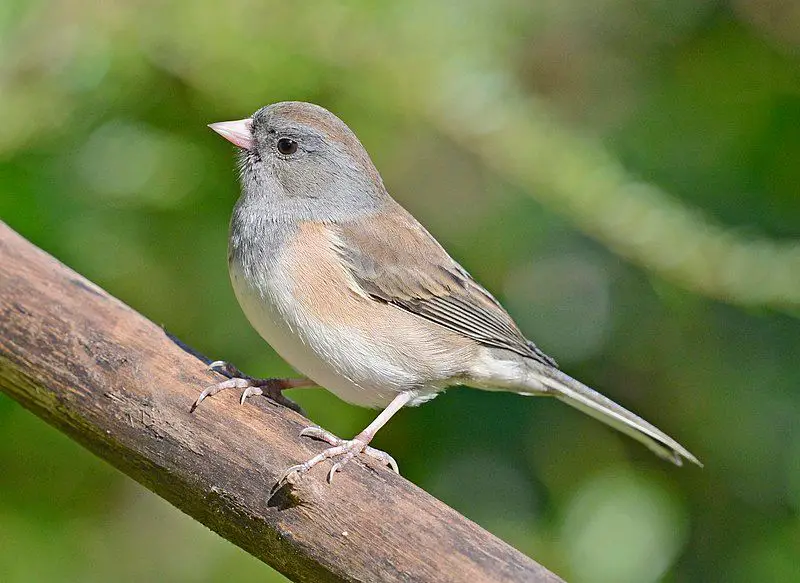
The dark-eyed junco is a type of bird called a junco. Juncos are small, grayish sparrows that live in the New World. The dark-eyed junco is found in many parts of temperate North America; during the summer, it even goes as far as the Arctic.
The dark-eyed junco is a species that has a lot of variation. This means that different individuals of this bird can look quite different from one another. It is similar to another species of sparrow called the fox sparrow in terms of its variability.
Despite being studied by scientists, the systematics of the dark-eyed junco are still not fully understood. Systematics refers to exploring the relationships between different species and their classification.
So, even though researchers have been trying to figure out how the dark-eyed junco fits into the larger picture of bird species, there are still some unanswered questions.
| Kingdom | Animalia |
| Phylum | Chordata |
| Clade | Dinosauria |
| Class | Aves |
| Order | Passeriformes |
| Family | Passerellidae |
| Genus | Junco |
| Species | J. hyemalis |
9. American Tree Sparrow
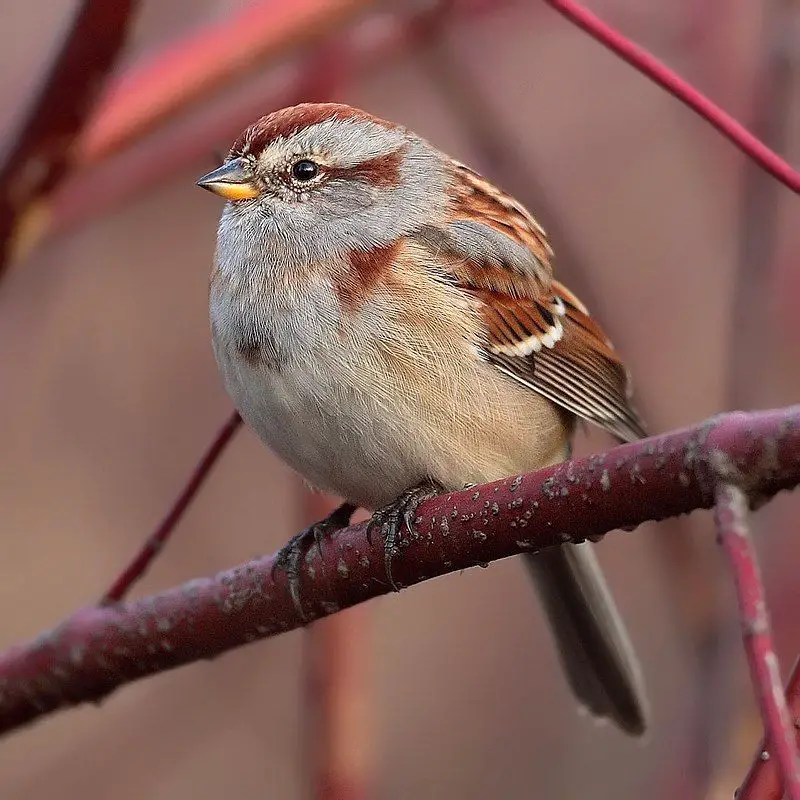
The American tree sparrow is a type of bird that is commonly found in North America. It is also known by another name, which is the winter sparrow.
This bird is medium-sized compared to other sparrows in the New World. The American tree sparrow is easily recognizable due to its distinct physical features. It has a plump body with a rounded head and a short tail. Its beak is cone-shaped and designed for eating seeds.
The bird’s plumage is mostly brown and gray, with a white belly and a chestnut-colored cap on its head. During the winter, the American tree sparrow migrates from its breeding grounds in the Arctic tundra to more southern regions of North America.
It seeks out habitats such as forests, thickets, and shrubby areas. This bird prefers to perch on branches rather than hopping on the ground like some other species of sparrows. In terms of diet, the American tree sparrow primarily feeds on seeds.
It prefers seeds from grasses, weeds, and various plants. It uses its beak to crack open the seeds’ hard shells, allowing it to access the nutritious interior. The breeding season for the American tree sparrow occurs during the summer.
| Kingdom | Animalia |
| Phylum | Chordata |
| Clade | Dinosauria |
| Class | Aves |
| Order | Passeriformes |
| Family | Passerellidae |
| Genus | Spizelloides |
| Species | S. arborea |
10. Tufted Titmouse
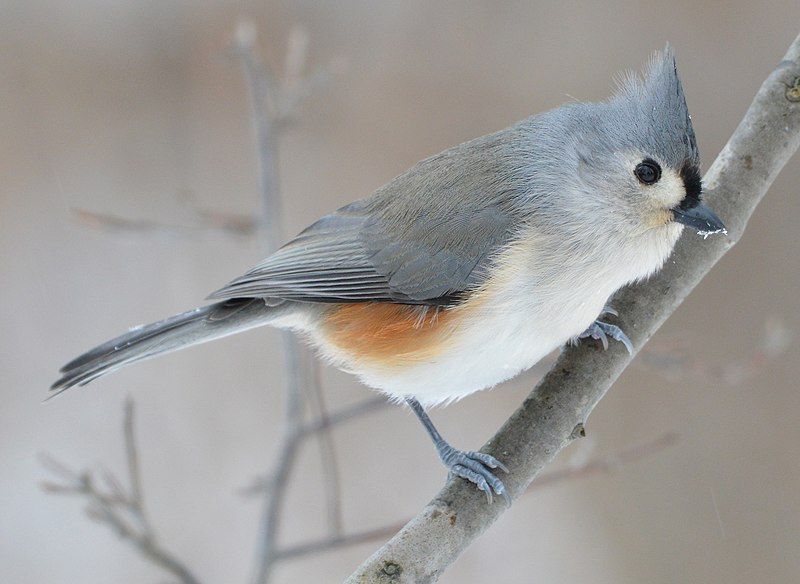
The tufted titmouse is a little bird found in North America. It belongs to the tit and chickadee family, which means it is closely related to other birds in that family.
In the past, another bird called the black-crested titmouse was thought to be a subspecies of the tufted titmouse. This means they were very similar in appearance and behavior but slightly different.
However, scientists have determined that the black-crested titmouse is a separate species. It is officially called Baeolophus atricristatus. The black-crested titmouse is found in central and southern Texas, extending southward.
This means it can also be seen in areas further south from Texas. This separation of the black-crested titmouse from the tufted titmouse is essential in the scientific world.
It helps us understand the diversity of bird species and how they are related to each other. Learning about these small songbirds and the distinctions between different species is fascinating.
Scientists can gain valuable insights into the natural world and the incredible by studying and understanding these differences.
| Kingdom | Animalia |
| Phylum | Chordata |
| Clade | Dinosauria |
| Class | Aves |
| Order | Passeriformes |
| Family | Paridae |
| Genus | Baeolophus |
| Species | B. bicolor |
11. Song Sparrow
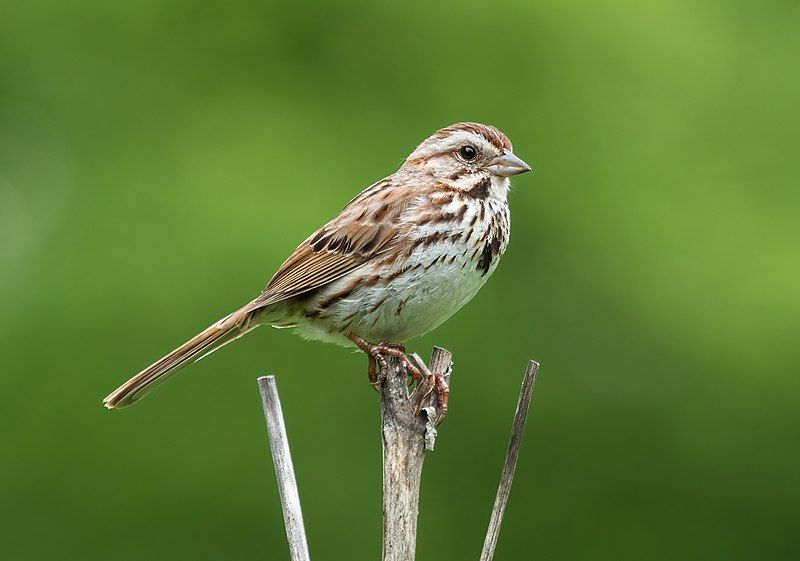
The song sparrow is a type of sparrow found in North America. It is considered to be medium-sized in comparison to other sparrows. Out of all the sparrows native to North America, the song sparrow is known to be one of the most abundant species.
This means that there are a large number of song sparrows in the wild. Not only is the song sparrow abundant, but it is also quite variable. This means that there can be different variations or types of song sparrows. They may have slight differences in appearance or behavior.
In addition to being abundant and variable, the song sparrow is also adaptable. This means that it can adjust well to different environments and conditions. It can thrive in various habitats, such as grasslands, marshes, and urban areas.
The adaptability of the song sparrow allows it to have a wide range of distribution. It can be found in many parts of North America, from Canada to Mexico. Overall, the song sparrow is a fascinating, medium-sized, abundant, variable, and adaptable bird.
Its ability to adapt to different environments has contributed to its success as a species in North America.
| Kingdom | Animalia |
| Phylum | Chordata |
| Clade | Dinosauria |
| Class | Aves |
| Order | Passeriformes |
| Family | Passerellidae |
| Genus | Melospiza |
| Species | M. melodia |
12. Carolina Wren
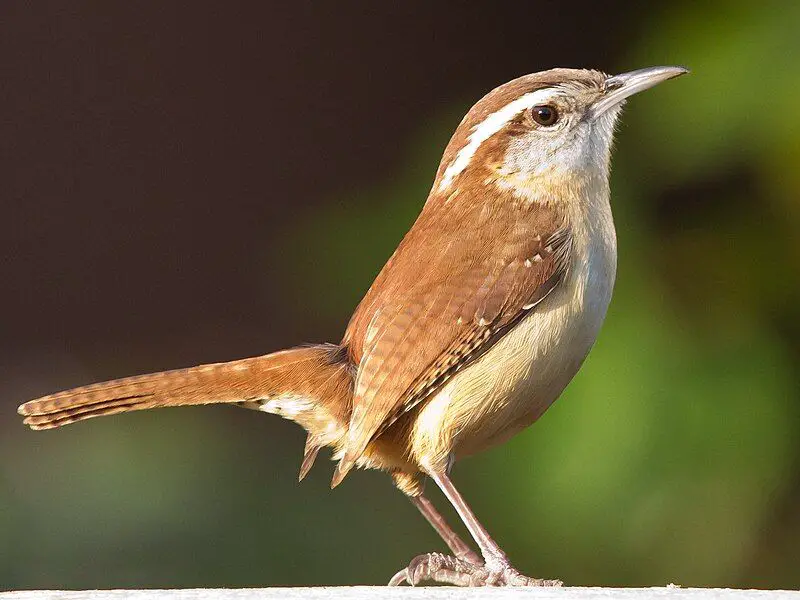
The Carolina wren is a type of wren bird found in several regions. It is considered a common species, frequently seen in these areas. The bird is mainly found in the eastern half of the United States of America.
This includes states like North Carolina, South Carolina, and Virginia. However, it can also be spotted in other states within this region. Apart from the United States, the Carolina wren is also seen in certain parts of Canada.
Specifically, it can be found in the extreme south of Ontario. This means it is only present in the southernmost part of the province.
This is interesting because the bird’s range extends beyond the borders of the United States. Additionally, the Carolina wren can be observed in the extreme northeast of Mexico.
This means it is in the northeastern part of the country, close to the border it shares with the United States.
This further highlights the bird’s ability to inhabit different regions within North America. The Carolina wren is a resident bird in the eastern half of the United States, the extreme south of Ontario, Canada, and the extreme northeast of Mexico.
It is a common species, often seen in these areas. Its range includes several states.
| Kingdom | Animalia |
| Phylum | Chordata |
| Clade | Dinosauria |
| Class | Aves |
| Order | Passeriformes |
| Family | Troglodytidae |
| Genus | Thryothorus |
| Species | T. ludovicianus |
13. Carolina Chickadee
The Carolina chickadee is a type of bird that belongs to the passerine bird family known as Paridae. It is a small bird that is often seen in North America.
The passerine bird family includes other birds like tits, which are known for their small size and agile nature. Carolina chickadees are known for their distinct appearance and behavior. They have a round body shape, short necks, and trim beaks.
Their feathers are primarily gray on the upperparts and white on the underparts, with black and white markings on their wings and tails.
This coloration helps them blend in with their surroundings and provides camouflage for protection. These birds are often found in deciduous and mixed forests and residential areas with trees and shrubs.
They prefer habitats with a variety of vegetation, including both coniferous and deciduous trees.
They are also known to visit bird feeders in people’s yards, especially during winter, when food is scarce. Carolina chickadees are social birds and are often seen in small flocks.
They communicate with each other through a variety of vocalizations, including their well-known “chick-a-dee-dee-dee” call.
| Kingdom | Animalia |
| Phylum | Chordata |
| Clade | Dinosauria |
| Class | Aves |
| Order | Passeriformes |
| Family | Paridae |
| Genus | Poecile |
| Species | P. carolinensis |
14. Woodpeckers
Woodpeckers belong to a bird family called Picidae. This family also includes other birds like piculets, wrynecks, and sapsuckers. Members of the Picidae family can be found all around the world, except in certain places.
Australia, New Guinea, New Zealand, Madagascar, and the extreme polar regions are where these birds are not found. Woodpeckers are unique birds known for their ability to peck and drum on trees.
They have specially adapted beaks and strong neck muscles that allow them to strike trees repeatedly. This behavior is used for feeding, communication, and establishing territories. Piculets are smaller woodpecker-like birds that belong to the Picidae family.
They have similar physical characteristics and behaviors as woodpeckers, but they are usually smaller in size. Wrynecks, another member of the Picidae family, are small, insect-eating birds with long, slender bills.
They are known for their ability to twist their necks in a snake-like fashion. Sapsuckers, also part of the Picidae family, are woodpeckers with unique feeding habits. They drill small holes in trees.
| Kingdom | Animalia |
| Phylum | Chordata |
| Clade | Dinosauria |
| Class | Aves |
| Order | Piciformes |
| Family | Picidae |
15. Northern Flicker
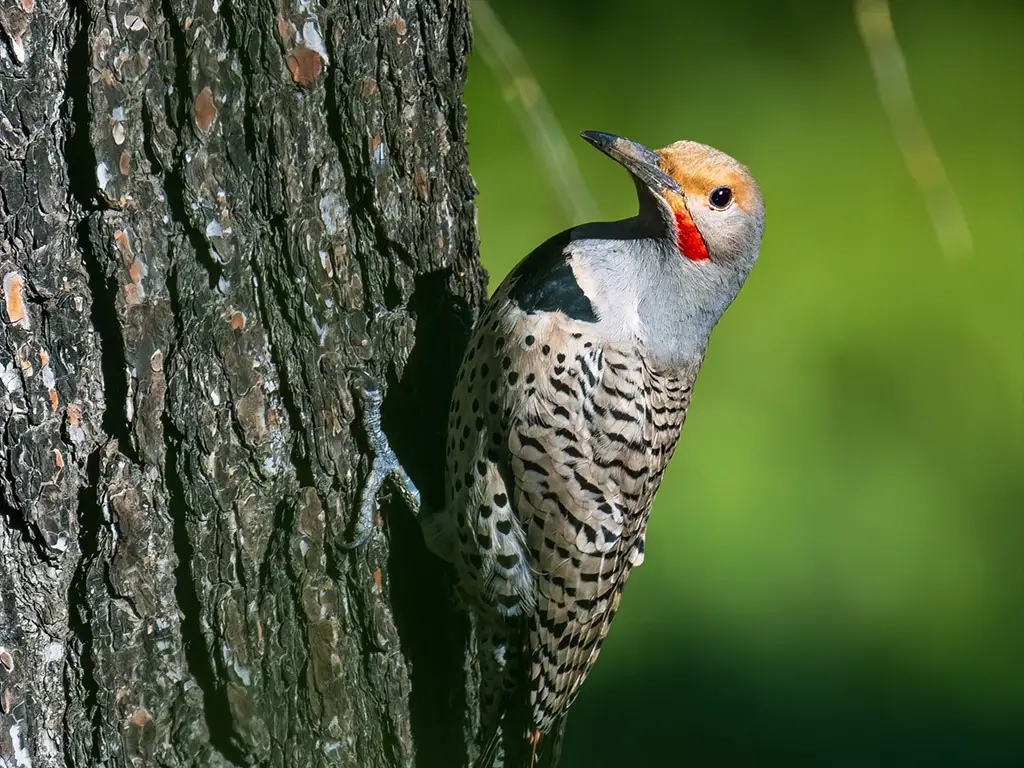
The northern flicker is a bird that belongs to the woodpecker family. It is not a very large bird but also not too small. The northern flicker can be found in many parts of North America.
It is also native to some areas in Central America, such as Cuba and the Cayman Islands. One exciting thing about the northern flicker is that it is one of the few woodpecker species that migrate.
Migration means these birds travel from one place to another during different seasons. They do this to find food and suitable habitats.
The northern flicker migrates to different regions depending on the time of year. During the breeding season, which is usually in the spring or summer, the northern flicker can be found in many parts of North America.
They build their nests in trees and use their strong beaks to create holes in the wood. These holes are called cavities and serve as their homes. Northern flickers are known for their distinctive markings.
They have a brown body with black spots, and their wings have a white patch easily visible when flying. Another unique feature is the red or yellow coloration on the underside of their wings and tail.
| Kingdom | Animalia |
| Phylum | Chordata |
| Clade | Dinosauria |
| Class | Aves |
| Order | Piciformes |
| Family | Picidae |
| Genus | Colaptes |
| Species | C. auratus |
16. Common Starling
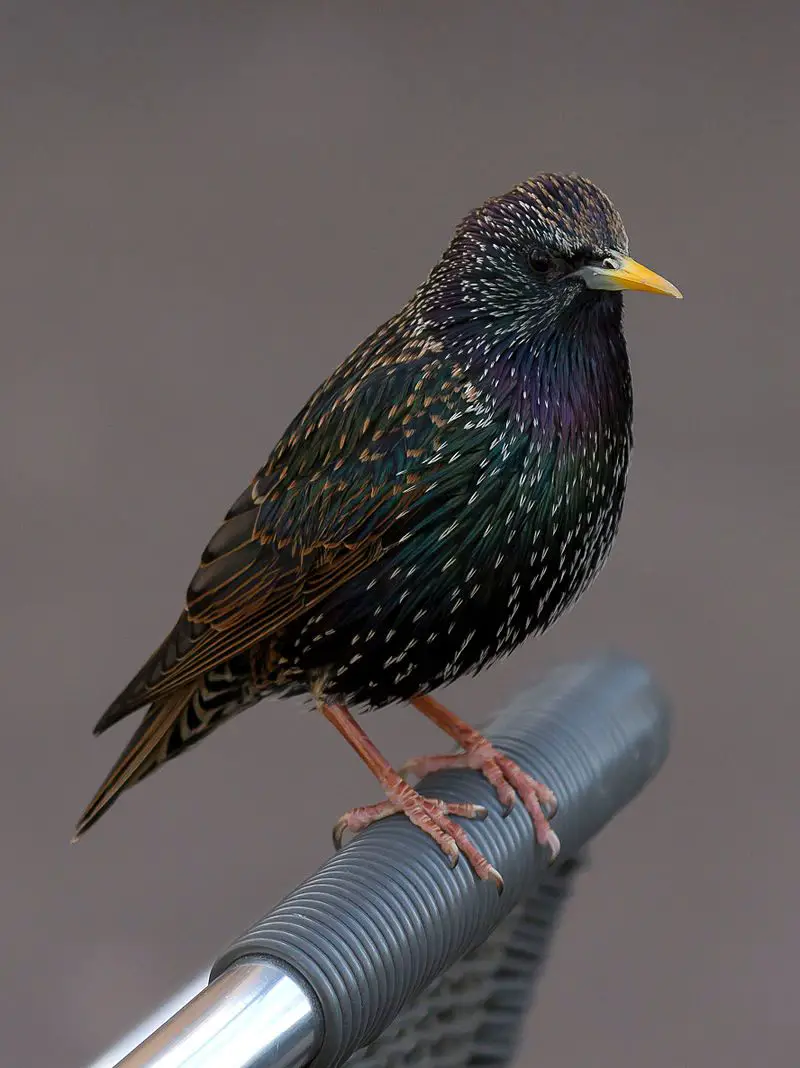
The common starling is a type of bird found in various regions. Depending on the location, it is referred to by different names. It is known as the European starling in North America, while in Great Britain and Ireland, it is called the starling.
This bird belongs to the starling family, scientifically known as Sturnidae. The common starling is classified as a passerine bird with a medium-sized build. Passerine birds are characterized by having feet adapted for perching, and they make up the most significant order of birds.
The starling family, to which the common starling belongs, is known for its diverse species worldwide. The common starling is known for its unique features and behaviors. It has a sleek and shiny black plumage with speckled spots, which gives it a distinct appearance.
The bird’s feathers can also appear iridescent in certain lighting conditions, showcasing shades of green and purple. One of the remarkable aspects of the common starling is its ability to mimic sounds and voices.
It has various vocalizations and can imitate various sounds in its environment, including other bird calls, human speech, and even mechanical noises.
| Kingdom | Animalia |
| Phylum | Chordata |
| Clade | Dinosauria |
| Class | Aves |
| Order | Passeriformes |
| Family | Sturnidae |
| Genus | Sturnus |
| Species | S. vulgaris |
17. Blue Jay
The blue jay is a bird that belongs to the family Corvidae. It can be found in eastern North America. This bird is commonly found in many eastern and central United States parts.
However, it is essential to note that some blue jays in the eastern regions may migrate to other areas. In addition to the United States, blue jays reside in Newfoundland, Canada. They are considered residents in this area.
Breeding populations of blue jays can be observed across southern Canada. This means that these birds reproduce and raise their young in this region. The blue jay is a passerine bird, meaning it has specialized feet that allow it to perch on tree branches.
It is native to eastern North America and can be found in various parts of the United States, Newfoundland, and southern Canada.
| Kingdom | Animalia |
| Phylum | Chordata |
| Clade | Dinosauria |
| Class | Aves |
| Order | Passeriformes |
| Family | Corvidae |
| Genus | Cyanocitta |
| Species | C. cristata |
18. American Robin
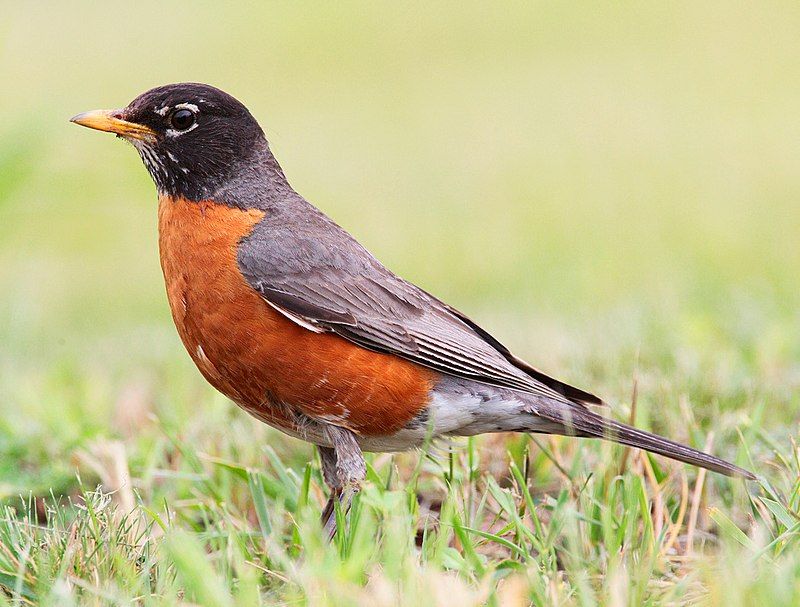
The American robin is a type of bird that migrates. It belongs to the valid thrush genus and the Turdidae family, a more prominent thrush family. It gets its name from the European robin because of its reddish-orange breast.
However, it must be noted that the American and European robin are not closely related. The European robin is a different species and belongs to the Old World flycatcher family.
Despite their similar names and physical characteristics, these two birds are not closely related regarding their genetic makeup.
They may share some similarities in appearance, such as the reddish-orange breast, but their evolutionary paths have taken them in different directions. The American robin is primarily found in North America, while the European robin is native to Europe and parts of Asia.
Both species have adapted to their respective environments and habitats over time.
The American robin is known for its ability to migrate long distances, often traveling south during winter and returning north for breeding season. Regarding physical characteristics, the American robin is larger than the European robin.
It has a grayish-brown back and a distinct reddish-orange breast, a defining feature of the species.
| Kingdom | Animalia |
| Phylum | Chordata |
| Clade | Dinosauria |
| Class | Aves |
| Order | Passeriformes |
| Family | Turdidae |
| Genus | Turdus |
| Species | T. migratorius |
19. White-Throated Sparrow
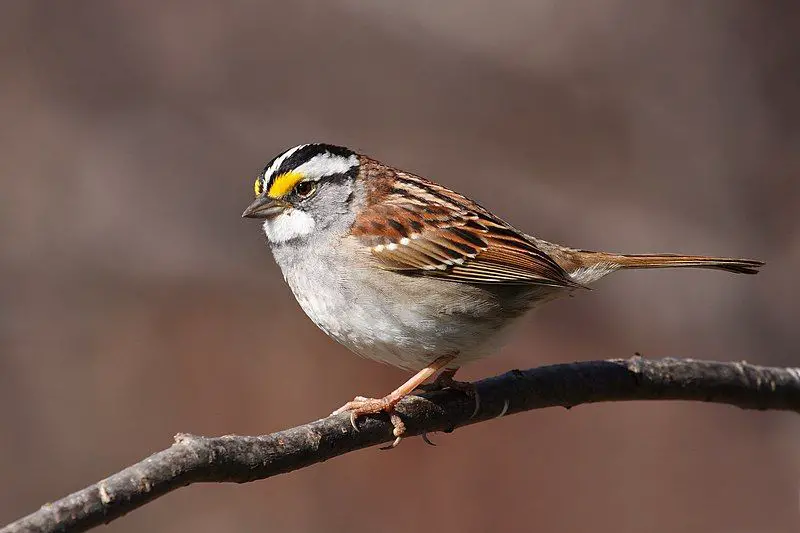
The white-throated sparrow is a type of bird that belongs to the passerine family called Passerellidae. This family of birds is commonly known as New World sparrows. Passerines are a diverse group of birds that make up more than half of all bird species.
They are known for their unique ability to perch and grip onto branches with their feet. The white patch on its throat easily distinguishes the white-throated sparrow. This feature gives the bird its name.
These sparrows are native to North America and can be found throughout the continent, from Canada to Mexico. They are migratory birds, meaning they travel long distances during certain times of the year.
During the breeding season, white-throated sparrows are known for their distinct song, which can be described as a whistling “Oh sweet Canada, Canada, Canada.” This song helps them attract mates and establish their territory.
White-throated sparrows are relatively small birds, measuring about 6 to 7 inches long. They have a plump body with a rounded head and a short tail. Their plumage consists of a combination of gray, brown, and black feathers.
| Kingdom | Animalia |
| Phylum | Chordata |
| Clade | Dinosauria |
| Class | Aves |
| Order | Passeriformes |
| Family | Passerellidae |
| Genus | Zonotrichia |
| Species | Z. albicollis |
20. American Crow
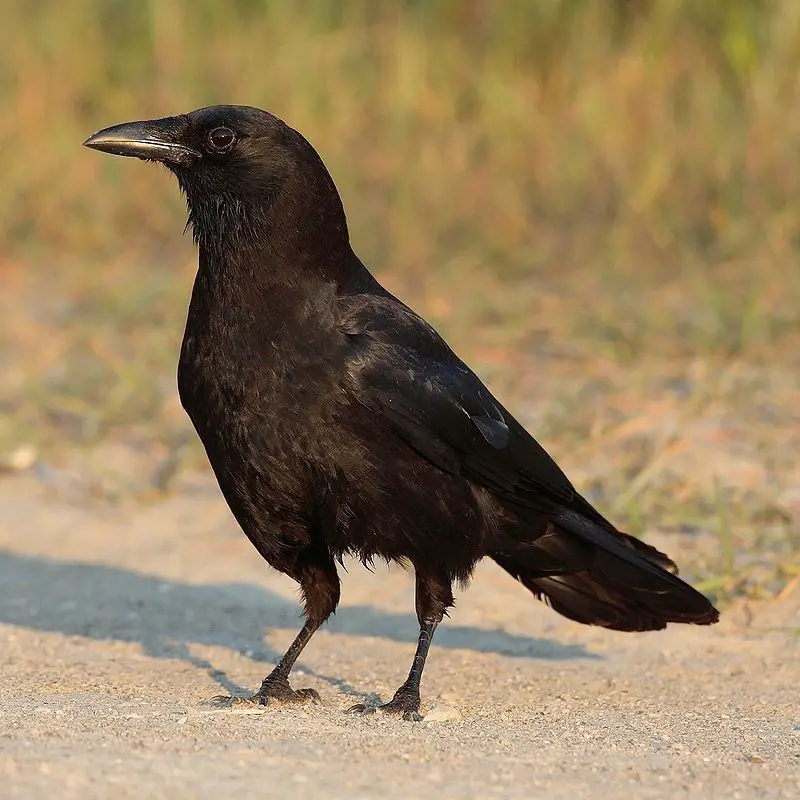
The American crow is a type of bird that belongs to the Corvidae family. This family includes other birds like ravens and jays. The American crow is extensive and known as a passerine bird, meaning it has feet adapted for perching on branches.
You can find American crows in many parts of North America. They are widespread birds so that you might have seen them in your neighborhood. They have adapted well to different environments and can be found in urban areas, forests, and open fields.
Interestingly, American crows are similar to two other crows in different parts of the world. These are the carrion crow and the hooded crow found in Europe and Asia.
Despite being from different continents, these three crows occupy the same ecological niche. An ecological niche refers to the role a species plays in its environment. In this case, the American crow, carrion crow, and hooded crow have similar behaviors and habits.
They are opportunistic feeders, meaning they eat a wide range of things like insects, fruits, small animals, and even garbage. They also play essential roles in controlling populations of certain pests and scavenging.
| Kingdom | Animalia |
| Phylum | Chordata |
| Clade | Dinosauria |
| Class | Aves |
| Order | Passeriformes |
| Family | Corvidae |
| Genus | Corvus |
| Species | C. brachyrhynchos |
21. Eastern Bluebird
The eastern bluebird is a type of bird native to North America. It is known for its ability to migrate or travel from one place to another.
It prefers to live in open woodlands, farmlands, orchards with plenty of trees and open spaces. One notable feature of the eastern bluebird is its bright blue breeding plumage.
The male bluebird has this vibrant blue color on its feathers during the breeding season. This makes it easy to spot and observe when perched on a wire or in an open area.
Many birdwatchers, also known as birders, find the eastern bluebird a favorite species to observe because of its striking appearance. The blue color of the male bluebird’s feathers is often associated with the breeding season.
It is a way for the male to attract a mate and signal its reproduction readiness.
The bright plumage acts as a visual cue for potential mates, indicating that the male is healthy and capable of producing offspring. In addition to its blue feathers, the eastern bluebird has other distinctive physical characteristics.
It is smaller than other birds, allowing it to maneuver easily in its woodland and farmland habitats.
| Kingdom | Animalia |
| Phylum | Chordata |
| Clade | Dinosauria |
| Class | Aves |
| Order | Passeriformes |
| Family | Turdidae |
| Genus | Sialia |
| Species | S. sialis |
22. Mallard
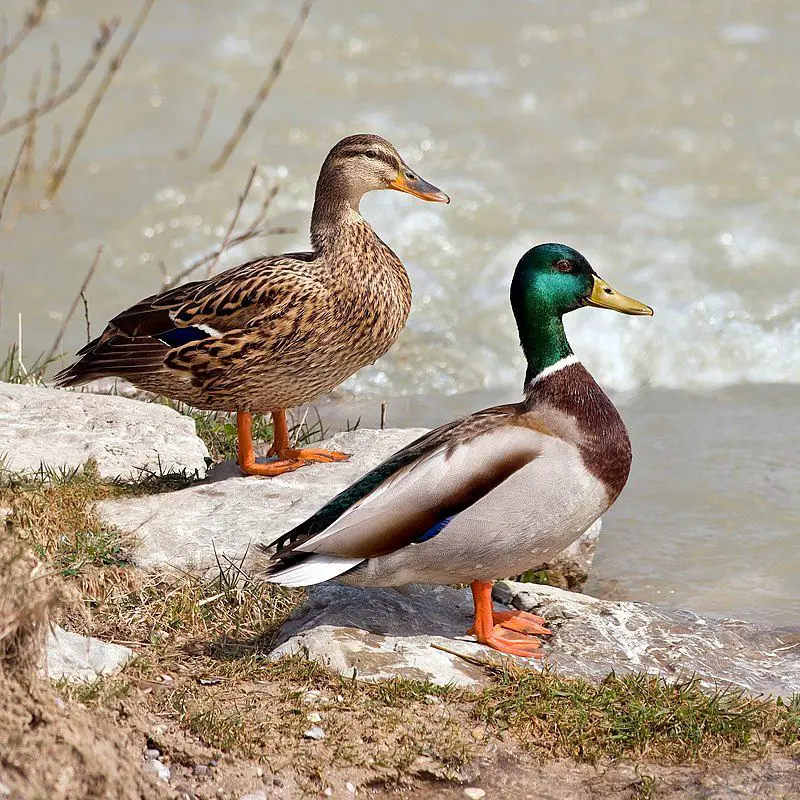
The mallard, also known as the wild duck, is a dabbling duck. It can be found breeding in various world regions, including the temperate and subtropical Americas, Eurasia, and North Africa.
This duck species has been introduced to several countries outside its native range. For example, mallards have been brought to New Zealand, Australia, Peru, Brazil, Uruguay, Argentina, Chile, Colombia, the Falkland Islands, and South Africa.
The mallard’s ability to adapt to different environments has allowed it to thrive in these introduced regions. It is a versatile bird that can adapt to various habitats, such as wetlands, ponds, lakes, and even urban areas. In its native range, the mallard is a migratory bird.
However, in some introduced areas, it has become resident, meaning it stays in one place throughout the year rather than undertaking long-distance migrations.
The mallard is known for its vibrant plumage, with males having a distinctive green head, yellow bill, and brownish body. Conversely, females have a mottled brown appearance, which helps them camouflage with their surroundings. As dabbling ducks, mallards feed.
| Kingdom | Animalia |
| Phylum | Chordata |
| Clade | Dinosauria |
| Class | Aves |
| Order | Anseriformes |
| Family | Anatidae |
| Genus | Anas |
| Species | A. platyrhynchos |
23. Pileated Woodpecker
The pileated woodpecker is a type of bird that is primarily black and is found in North America. It is a relatively large bird compared to other woodpeckers. The pileated woodpecker mostly eats insects, which makes it an insectivore.
It usually lives in deciduous forests located in eastern North America. In addition to the east part of North America, the pileated woodpecker can also be found in the Great Lakes region. It can be seen in Michigan, Minnesota, and the surrounding states.
The bird is also found in the boreal forests of Canada. These forests are characterized by primarily coniferous trees and are located in northern Canada. Furthermore, the pileated woodpecker can be spotted in certain areas along the Pacific Coast.
This means it can be found in states like Oregon and Washington. It is interesting that the bird’s habitat spans different regions, showing its adaptability to various environments.
Overall, the pileated woodpecker is a fascinating bird native to North America. Its black feathers and relatively large size make it easy to identify. It prefers to live in deciduous forests.
| Kingdom | Animalia |
| Phylum | Chordata |
| Clade | Dinosauria |
| Class | Aves |
| Order | Piciformes |
| Family | Picidae |
| Genus | Dryocopus |
| Species | D. pileatus |
24. Red-Winged Blackbird
The red-winged blackbird is a type of bird that belongs to the passerine family called Icteridae.
It is commonly found in various parts of North America and a significant portion of Central America. Passerines are a diverse group of birds known for their musical and complex songs.
They have specialized vocal organs that produce a wide range of sounds. The red-winged blackbird is easily recognizable due to its distinct appearance.
The male red-winged blackbird has glossy black plumage and bright red patches on its wings, which give it its name.
On the other hand, the female red-winged blackbird has a more subdued appearance with brown feathers and streaks. These birds have a unique habitat preference, as they are commonly found in wetlands, marshes, and areas with tall grasses.
They are skilled at perching on tall plants and reeds, where they can easily spot their prey and potential predators. Red-winged blackbirds primarily feed on insects, seeds, and grains. They use their sharp beaks to catch insects on the fly and extract seeds from plants.
During the breeding season, they may consume small vertebrates such as frogs and tadpoles.
| Kingdom | Animalia |
| Phylum | Chordata |
| Clade | Dinosauria |
| Class | Aves |
| Order | Passeriformes |
| Family | Icteridae |
| Genus | Agelaius |
| Species | A. phoeniceus |
25. Black-Capped Chickadee
The black-capped chickadee is a small songbird found in North America. It is known for its distinctive black cap and white cheeks.
This bird is not migratory, meaning it does not travel long distances during different seasons. The black-capped chickadee prefers to live in deciduous and mixed forests.
These types of forests provide the bird with the necessary habitat, such as trees and shrubs, where it builds its nests and finds food.
As a passerine bird, it belongs to the tit family, which is scientifically called Paridae. Interestingly, the black-capped chickadee holds special significance in certain regions.
It is the state bird of Massachusetts and Maine in the United States, symbolizing its importance to the local environment and culture.
Additionally, in Canada, specifically in the province of New Brunswick, it is recognized as the provincial bird. The black-capped chickadee is a small, nonmigratory songbird found in North America.
It thrives in deciduous and mixed forests and belongs to the tit family. Its significance is acknowledged through its designation as the state bird in Massachusetts and Maine and the provincial bird of New Brunswick.
| Kingdom | Animalia |
| Phylum | Chordata |
| Clade | Dinosauria |
| Class | Aves |
| Order | Passeriformes |
| Family | Paridae |
| Genus | Poecile |
| Species | P. atricapillus |
26. Sandhill Crane
The sandhill crane is a type of bird. It is a large crane found in North America and extreme northeastern Siberia. Its common name comes from the habitat it prefers, similar to the Platte River. This river is located on the edge of Nebraska’s Sandhills.
The Sandhills are part of the American Great Plains. The sandhill crane is known for its distinctive appearance and behavior. It has long legs and a long neck, which allows it to stand tall and walk gracefully. The bird has a grayish-brown body with patches of red on its head.
It also has a long, pointed beak to catch and eat food. These cranes are highly adapted to living in wetland areas. They can be found in marshes, bogs, and shallow lakes. The Platte River, for example, provides an ideal habitat for them.
The river’s sandbars, wetlands, and surrounding grasslands offer a perfect environment for the sandhill cranes to forage and rest. During their migration, sandhill cranes form large flocks that can number thousands.
They fly in a V-formation, using the air currents to conserve energy.
| Kingdom | Animalia |
| Phylum | Chordata |
| Clade | Dinosauria |
| Class | Aves |
| Order | Gruiformes |
| Family | Gruidae |
| Genus | Antigone |
| Species | A. canadensis |
27. Purple Finch
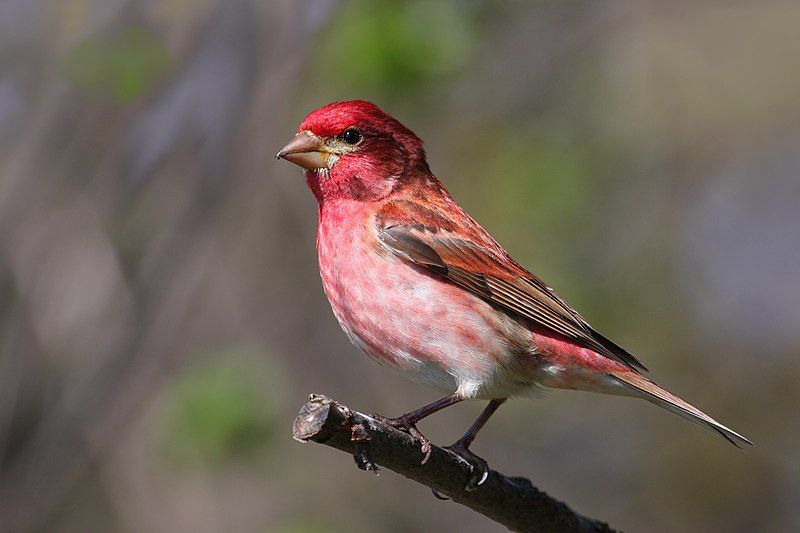
The purple finch is a type of bird. It belongs to the finch family called Fringillidae. This family includes various species of finches. The purple finch is one of them. This bird is found in different parts of North America.
It breeds in the northern United States, laying eggs and raising its young there. It also breeds in southern Canada, the region below the northern part of Canada.
Additionally, the bird can be found along the west coast of North America. Breeding refers to the process of reproduction in animals, where they mate and produce offspring. Like the purple finch, birds build nests and lay eggs for breeding.
They take care of their eggs until they hatch, then raise their chicks until they are ready to leave the nest. The purple finch is known for its vibrant purple coloration.
Males have a deep red or raspberry-colored plumage with a purple tint, while females have a more subdued plumage with streaks of brown and white.
This difference in appearance between males and females is called sexual dimorphism. In addition to its striking color, the purple finch has a sturdy beak well-suited for cracking open seeds.
| Kingdom | Animalia |
| Phylum | Chordata |
| Clade | Dinosauria |
| Class | Aves |
| Order | Passeriformes |
| Family | Fringillidae |
| Genus | Haemorhous |
| Species | H. purpureus |
28. Red-Headed Woodpecker
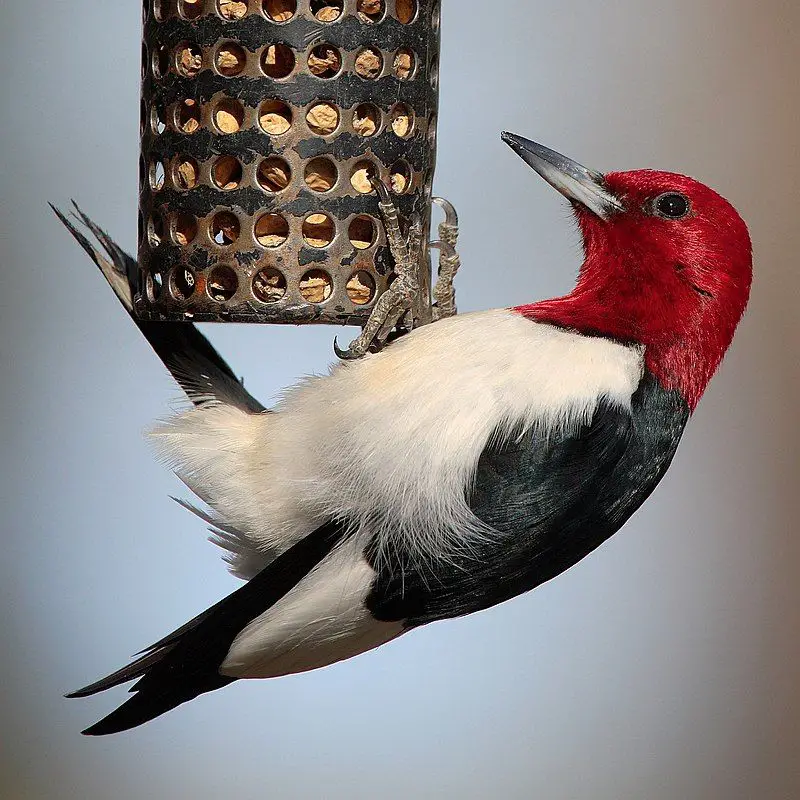
The red-headed woodpecker is a type found in temperate regions of North America. It is not too big or too small, but rather a mid-sized bird. This woodpecker is known for its distinct red head, which sets it apart from other species.
Its vibrant red color stands out against its black and white body. Regarding its habitat, the red-headed woodpecker prefers open areas in southern Canada and the east-central United States. It is specifically found in regions with a moderate climate.
This woodpecker builds its nests during the breeding season in these open country habitats. It looks for suitable spots to create its nest, often choosing dead trees or branches.
The red-headed woodpecker is a skilled excavator, using its strong beak to make holes in the trees for its nests. These holes not only serve as a nesting site but also as a source of food storage.
In addition to nesting, the red-headed woodpecker also searches for food in its breeding habitat. It feeds on various insects, fruits, nuts, and even small vertebrates. This woodpecker is known for its agility and acrobatics.
| Kingdom | Animalia |
| Phylum | Chordata |
| Clade | Dinosauria |
| Class | Aves |
| Order | Piciformes |
| Family | Picidae |
| Genus | Melanerpes |
| Species | M. erythrocephalus |
29. Canada Goose
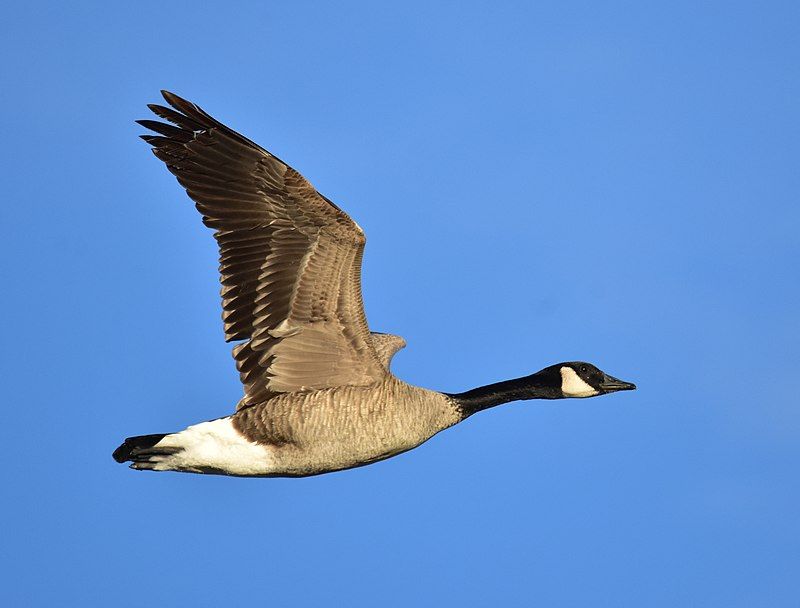
The Canada goose is a type of wild goose that can also be called the Canadian goose. It is pretty significant and has distinct physical features. One of its notable characteristics is a black head and neck.
Additionally, it has white cheeks and a white area under its chin. The body of the Canada goose is typically brown. This goose species is originally from North America’s Arctic and temperate regions. It is well-adapted to these colder climates.
However, during migration, the Canada goose has been known to travel across the Atlantic and can occasionally be found in northern Europe. The Canada goose is a fascinating bird that has captured the attention of many due to its unique appearance.
Its black head and neck contrast sharply against its white cheeks and chin.
This distinctive coloration helps to identify the Canada goose from other species quickly. Native to North America’s arctic and temperate regions, the Canada goose has evolved to survive in harsh environments.
Its adaptations to cold climates include a sturdy build and insulating feathers.
These features enable the goose to endure freezing temperatures and harsh weather conditions. Although primarily found in North America, the Canada goose exhibits exciting behavior during migration. It has been observed crossing.
| Kingdom | Animalia |
| Phylum | Chordata |
| Clade | Dinosauria |
| Class | Aves |
| Order | Anseriformes |
| Family | Anatidae |
| Genus | Branta |
| Species | B. canadensis |
30. Brown-Headed Cowbird
The brown-headed cowbird is a bird species found in temperate and subtropical regions of North America. It is known for its behavior as a brood parasite, meaning it lays its eggs in the nests of other bird species.
This behavior is obligatory for the brown-headed cowbird, which means it relies on other birds to raise its young. The brown-headed cowbird is a small bird with a brown head and dark body.
It is commonly found in the southern parts of its range throughout the year, where it remains a permanent resident.
However, the birds from the northern regions migrate to the southern United States and Mexico during the winter season. The migration of the North brown-headed cowbirds occurs because the colder conditions in their northern habitats make it challenging to find sufficient food during the winter months.
Traveling to the southern regions, where the climate is milder and food resources are more abundant, increases their chances of survival. The migration typically takes place in a southward direction, starting around the onset of winter.
These birds undertake a long journey, often flying miles to reach their wintering grounds. They remain in these warmer regions until spring, around March or April, after winter.
| Kingdom | Animalia |
| Phylum | Chordata |
| Clade | Dinosauria |
| Class | Aves |
| Order | Passeriformes |
| Family | Icteridae |
| Genus | Molothrus |
| Species | M. ater |
31. Wrens
Wrens are a type of bird that belongs to the family Troglodytidae. They are mainly found in the New World, which includes the Americas.
There are about 88 species of wrens, and they are categorized into 19 different genera, which is a higher taxonomic rank. Interestingly, only one wren species, the Eurasian wren, can be found in the Old World.
The Old World refers to regions such as Europe, Asia, and Africa. In English-speaking countries, this particular wren is called just “wren.”This is because the Eurasian wren is believed to be the original wren species that gave rise to the name.
Over time, as people encountered different species of wrens in the New World, they started using more specific names to differentiate them.
However, the name “wren” stuck with the Eurasian species because it was discovered and named first. So, when people in Anglophone regions say “wren,” they are usually referring to the Eurasian wren.
It is essential to note that this is a regional naming convention and may not be accurate in other languages or parts of the world.
| Kingdom | Animalia |
| Phylum | Chordata |
| Clade | Dinosauria |
| Class | Aves |
| Order | Passeriformes |
| Family | Troglodytidae |
32. Pine Siskin
The pine siskin is a type of bird found in North America. It belongs to the finch family, which includes other small birds like sparrows and goldfinches.
The pine siskin is known for its ability to migrate, meaning it travels from one place to another depending on the season. During the winter, the pine siskin’s range becomes very unpredictable.
It moves around sporadically instead of following a specific pattern or staying in one place.
Predicting where precisely these birds will be during the winter months can be challenging. The reason behind the pine siskin’s sporadic winter range is not entirely understood.
It is believed that factors like food availability and weather conditions play a role in determining their movements.
When specific food sources become scarce in one area, the birds may move to another location in search of better resources. The pine siskin’s winter range can vary from year to year.
One winter, they might be seen in large numbers in a particular region, while the following winter, they may be scarce or absent from the same area.
This unpredictability adds to the bird’s unique characteristics and makes it an interesting species to study. Researchers and bird enthusiasts often.
| Kingdom | Animalia |
| Phylum | Chordata |
| Clade | Dinosauria |
| Class | Aves |
| Order | Passeriformes |
| Family | Fringillidae |
| Genus | Spinus |
| Species | S. pinus |
33. Red-Breasted Nuthatch
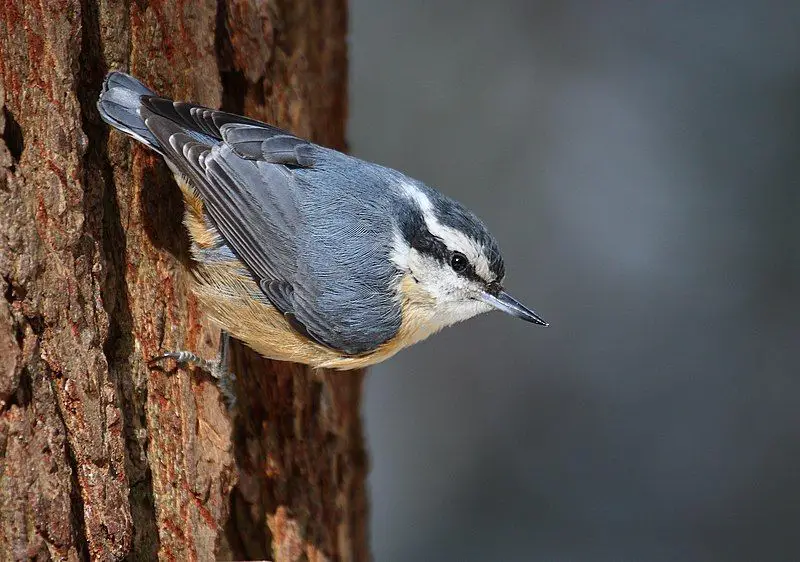
The red-breasted nuthatch is a small bird known for its beautiful appearance and unique characteristics. It has blue-grey feathers on its upper body and cinnamon-colored feathers on its underparts.
This combination of colors creates a striking contrast. Looking closely at the red-breasted nuthatch, you will notice a white throat and face. These white areas provide a stark contrast against the rest of its body.
Additionally, a distinct black stripe runs through its eyes, giving it a charming and distinctive look. Another notable feature of the red-breasted nuthatch is its straight grey bill.
This bill is perfectly shaped for its feeding habits, allowing it to crack open seeds and nuts easily. The bird’s bill is functional and adds to its overall appearance. One of the most striking features of the red-breasted nuthatch is its black crown.
This black area on its head gives the bird a regal and elegant look. Combined with its blue-grey and cinnamon colors, the black crown adds a touch of sophistication to its appearance. Apart from its visual characteristics, the red-breasted nuthatch has a unique call.
Described as a tin trumpet, its call is high-pitched.
| Kingdom | Animalia |
| Phylum | Chordata |
| Clade | Dinosauria |
| Class | Aves |
| Order | Passeriformes |
| Family | Sittidae |
| Genus | Sitta |
| Species | S. canadensis |
34. Ruby-Throated Hummingbird
The ruby-throated hummingbird is a type of hummingbird that has a bright red throat. This species is known for its unique migration pattern. These hummingbirds can be found in Central America, Mexico, and Florida during the winter months.
They choose these warmer regions because they provide a more suitable climate for survival. However, the ruby-throated hummingbird embarks on an incredible journey when the summer season arrives.
They migrate to Canada and other parts of Eastern North America to breed.
This long-distance migration allows them to take advantage of the abundant resources available in these areas during the summer months. The reason behind this seasonal migration is quite fascinating.
In Central America, Mexico, and Florida, the ruby-throated hummingbirds find a variety of nectar-producing flowers that provide them with a sufficient food source.
These flowers bloom during the winter, ensuring the hummingbirds have enough energy to survive. But as the seasons shift and the temperatures rise, the flowers in these regions begin to wither away.
This scarcity of food prompts the hummingbirds to undertake their impressive journey northward. They instinctively know that Canada and Eastern North America offer abundant nectar-producing flowers during the summer, which is ideal for them.
| Kingdom | Animalia |
| Phylum | Chordata |
| Clade | Strisores |
| Class | Aves |
| Order | Apodiformes |
| Family | Trochilidae |
| Genus | Archilochus |
| Species | A. colubris |
35. Great Horned Owl
The great horned owl is a species of owl found in the Americas. Other names, such as the tiger owl and the hoot owl, also know it.
This owl is known for its adaptability and can be found in various habitats across its wide range. Being a large owl, the great horned owl has a distinct appearance. It has prominent ear tufts on its head, which give it a horned appearance.
This characteristic distinguishes it from other owl species. One of the remarkable traits of the great horned owl is its adaptability. It can be found in many habitats, including forests, deserts, mountains, and urban areas.
This versatility allows the owl to thrive in diverse environments, making it the most widely distributed true owl in the Americas. The great horned owl is a skilled hunter, preying on various animals. Its diet includes small mammals like rabbits, mice, and rats.
Additionally, it feeds on birds, reptiles, amphibians, and even other owls. This owl species has excellent hunting abilities. It possesses sharp talons and a powerful beak, which it uses to catch and kill its prey.
Its wings are designed for silent flight, allowing it to approach.
| Kingdom | Animalia |
| Phylum | Chordata |
| Clade | Dinosauria |
| Class | Aves |
| Order | Strigiformes |
| Family | Strigidae |
| Genus | Bubo |
| Species | B. virginianus |
36. Snow Bunting
The snow bunting is a type of bird that belongs to the passerine family called Calcariidae. This family includes various species of birds known for their perching abilities. Unlike many other birds, the snow bunting is specially adapted to survive in the Arctic.
It is considered an Arctic specialist because its unique features help it thrive in this cold and harsh environment. One of the distinctive characteristics of the snow bunting is its circumpolar Arctic breeding range.
This means it can be found breeding throughout the entire Arctic region in the northern hemisphere. It can survive and reproduce in areas with extreme temperatures and limited resources.
The circumpolar Arctic breeding range of the snow bunting indicates that it is well adapted to the Arctic conditions. It can be found in various countries, such as Canada, Greenland, Iceland, Russia, and Norway.
It can find suitable breeding grounds and sufficient food sources in these regions. During the breeding season, the snow bunting constructs its nests on the ground in open areas such as tundra or rocky slopes.
This nesting behavior helps protect the eggs and young birds from predators, as the open environment allows for better visibility.
| Kingdom | Animalia |
| Phylum | Chordata |
| Clade | Dinosauria |
| Class | Aves |
| Order | Passeriformes |
| Family | Calcariidae |
| Genus | Plectrophenax |
| Species | P. nivalis |
37. Indigo Bunting
The indigo bunting is a bird that belongs to the cardinal family. It is known for its small size and diet, mainly of seeds. This bird is migratory, meaning it travels from one place to another depending on the season.
It can be found in southern Canada up to northern Florida during the breeding season. However, during the winter, it moves to southern Florida and even as far as northern South America. Interestingly, the indigo bunting has a unique way of migrating.
It prefers to travel at night, using the stars as a guide. This ability to use celestial cues demonstrates the bird’s remarkable sense of direction.
It can accurately find its way to its desired destination by relying on the stars. Migrating at night provides certain advantages for the indigo bunting. Firstly, the cooler temperatures at night make it more comfortable for the bird to travel long distances.
Additionally, flying during the night reduces the risk of predation, as many predators are less active during those hours.
This allows the indigo bunting to avoid potential dangers and increases its chances of survival during its journey. The indigo bunting’s reliance on the stars also showcases its ability to perceive and interpret celestial patterns.
| Kingdom | Animalia |
| Phylum | Chordata |
| Clade | Dinosauria |
| Class | Aves |
| Order | Passeriformes |
| Family | Cardinalidae |
| Genus | Passerina |
| Species | P. cyanea |
38. Northern Saw-Whet Owl
The northern saw-whet owl belongs to the family Strigidae and is a small owl species. It is originally from North America. This type of owl is part of the genus Aegolius and is known for being one of the smallest owl species in North America.
They are commonly found in dense thickets, where they tend to stay at eye level, making them easier to spot. However, they can also be observed perched up to about 20 feet above the ground.
The northern saw-whet owl is well-adapted to its habitat, which includes forests and woodlands. They have excellent camouflage skills, blending with the surrounding trees and vegetation.
These owls are mainly active at night, using their keen eyesight and hearing to hunt for prey. Their diet primarily consists of small mammals, such as mice and voles. Despite their small size, saw-whet owls have a distinctive call.
Their vocalizations are often described as a repetitive, high-pitched tooting sound, similar to the noise made by a saw being sharpened. Breeding season for these owls typically occurs during the spring. The female lays a clutch of eggs in a tree cavity or abandoned.
| Kingdom | Animalia |
| Phylum | Chordata |
| Clade | Dinosauria |
| Class | Aves |
| Order | Strigiformes |
| Family | Strigidae |
| Genus | Aegolius |
| Species | A. acadicus |
39. Blackburnian Warbler
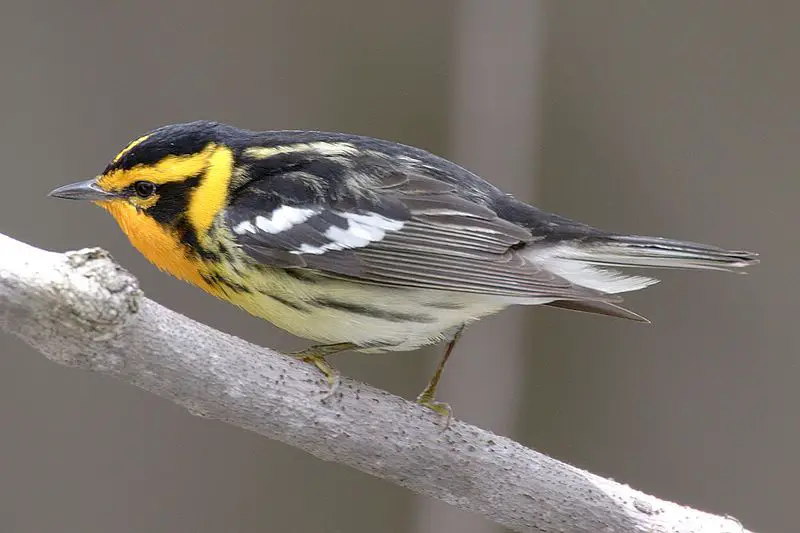
The Blackburnian warbler is a type of bird found in the New World. It is a small bird and belongs to the warbler family. These birds are known for their vibrant colors and beautiful plumage.
The Blackburnian warbler has a fiery orange throat and breast, which makes it stand out among other singers. Blackburnian warblers can be found in eastern North America during the breeding season. They choose to breed in various habitats, such as forests and woodlands.
Their breeding range stretches from southern Canada to the south of the Canadian Prairies. They also breed in the Great Lakes region and New England. These birds prefer to build their nests in tall trees, often near the edges of forests.
The female Blackburnian warbler constructs the nest using twigs, grass, and moss. After the breeding season, Blackburnian warblers migrate to their wintering grounds. They undertake a long journey south to escape the cold temperatures of North America.
During winter, these warblers can be found in Central and South America. They seek out lush tropical forests and spend their time foraging for insects and other small creatures. The Blackburnian warbler’s migration route takes.
| Kingdom | Animalia |
| Phylum | Chordata |
| Clade | Dinosauria |
| Class | Aves |
| Order | Passeriformes |
| Family | Parulidae |
| Genus | Setophaga |
| Species | S. fusca |
40. Grebes
Grebes are a type of bird that live in water and dive underwater. They belong to the order Podicipediformes. These birds are found in various freshwater habitats and can be seen in marine environments during migration and winter.
Many different species of grebes exist, and they are spread out over a wide area. Some species are even capable of flight, while others are flightless.
Interestingly, flightless grebes are most commonly found in lakes with a stable and consistent environment. Flightless grebes cannot fly like other birds due to particular physical adaptations.
However, they have evolved to be excellent swimmers and divers. Their wings have become smaller and less efficient for flying, but they have strong legs and webbed feet that help them propel through the water.
Grebes are known for their ability to dive underwater in search of food. They have specialized adaptations for this, such as dense bones that make them less buoyant and allow them to dive deeper.
Their feathers are also waterproof, which helps keep them dry and warm while swimming. These birds have a varied diet, mainly small fish, insects, and aquatic vegetation. They use their sharp beaks to catch their prey while.
| Kingdom | Animalia |
| Phylum | Chordata |
| Clade | Mirandornithes |
| Class | Aves |
| Order | Podicipediformes |
| Family | Podicipedidae |
41. Evening Grosbeak
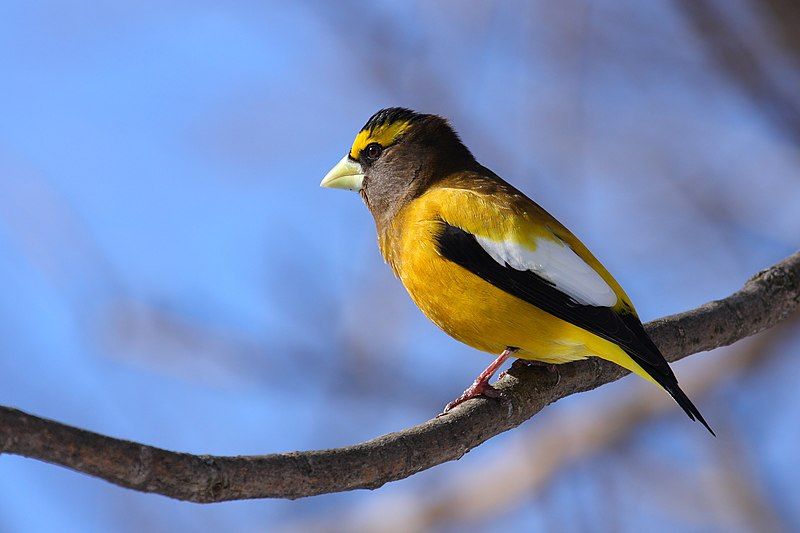
The evening grosbeak is a type of bird from the finch family found in North America. It is known for its bulky body, large bill, and short tail. Scientists have classified it under the genus Hesperiphona.
| Kingdom | Animalia |
| Phylum | Chordata |
| Clade | Dinosauria |
| Class | Aves |
| Order | Passeriformes |
| Family | Fringillidae |
| Genus | Hesperiphona |
| Species | H. vespertina |
42. Snowy Owl
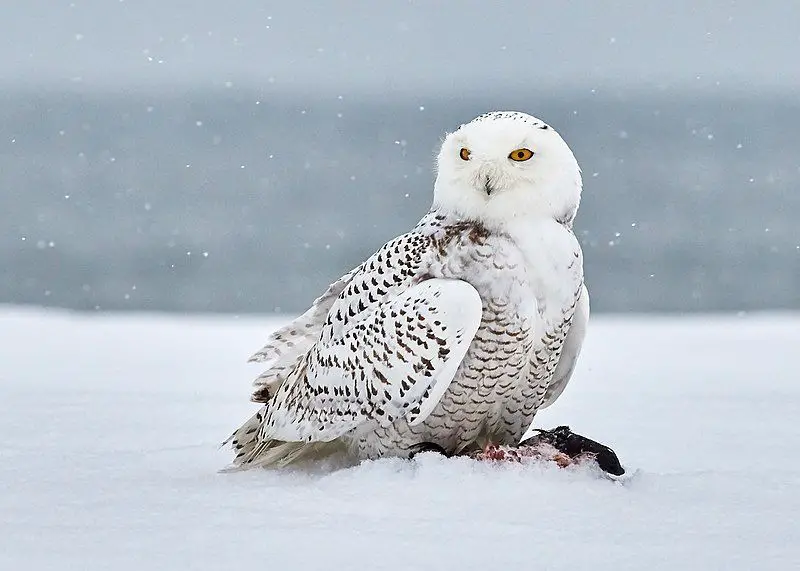
The snowy owl is a type of owl known by other names, such as polar, white, and Arctic owl. It belongs to the true owl family and is characterized by its large size and white feathers.
These owls can be found in both North America and the Palearctic regions, specifically in the Arctic areas. Snowy owls are well adapted to their harsh Arctic environments.
They have evolved to blend in with the snowy landscapes, which helps them remain camouflaged and hidden from predators.
Their white feathers act as a protective cover, allowing them to hunt and survive in their habitat. One interesting fact about snowy owls is that they are predominantly found in the tundra regions.
The tundra is a cold and treeless biome characterized by low temperatures and short summers. This environment provides ideal conditions for the snowy owl’s breeding. During the breeding season, snowy owls build their nests on the ground.
They use the tundra’s vegetation and materials like feathers and moss to construct their nests. This nesting behavior is unique among owls, as most other owl species prefer to nest in trees. Snowy owls feed primarily on small mammals, such as lemmings and voles.
| Kingdom | Animalia |
| Phylum | Chordata |
| Clade | Dinosauria |
| Class | Aves |
| Order | Strigiformes |
| Family | Strigidae |
| Genus | Bubo |
| Species | B. scandiacus |
43. Cedar Waxwing
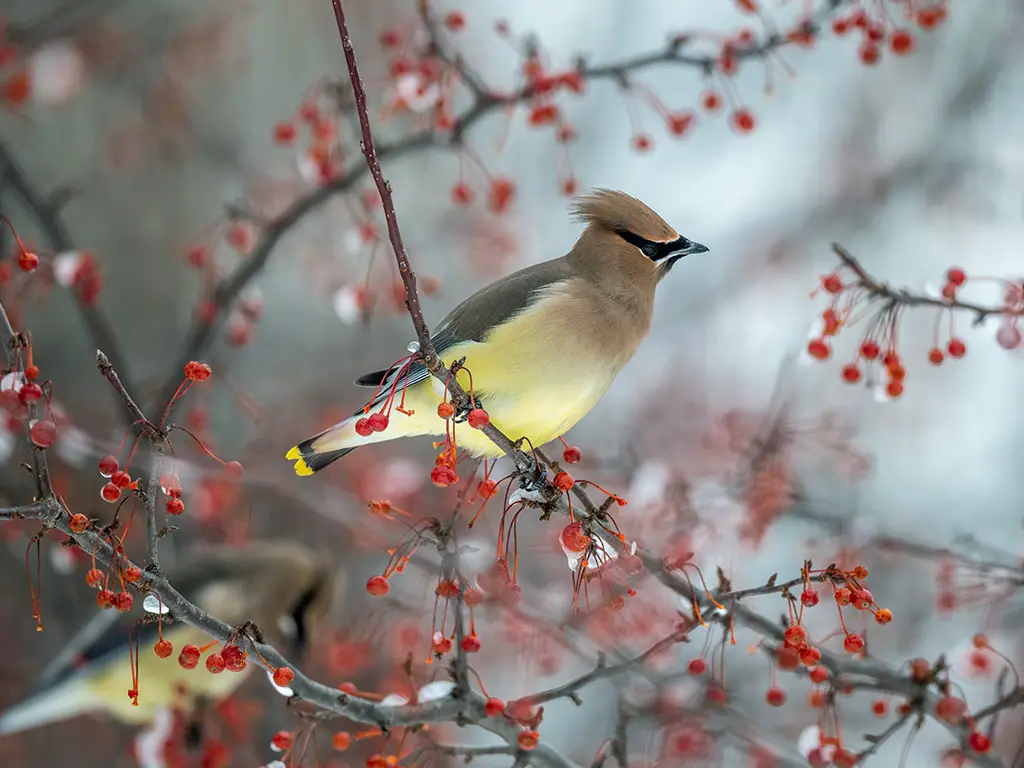
The cedar waxwing is a type of bird that belongs to the waxwing family of passerine birds known as Bombycillidae. Passerine birds are perching birds, which means they have feet adapted for gripping branches.
The cedar waxwing is a medium-sized bird with a distinctive appearance. Its feathers are mostly brown, gray, and yellow.
These colors help the bird blend well with its surroundings, making it harder for predators to spot it. One of the most unique features of the cedar waxwing is its wings. The bird gets its name from the wax-like tips on its wings.
These wing tips look like they have been dipped in wax, giving the bird a fascinating and memorable look. The wax-like wing tips serve a purpose for the cedar waxwing. They are specialized feathers that help the bird in various ways.
The waxy substance on the wing tips repels water, allowing the bird to fly more easily in wet weather conditions. It also helps the bird glide smoothly, reducing air resistance. Another exciting aspect of the cedar waxwing is its diet.
This bird primarily feeds on fruits, such as berries, and small fruits, like cherries. It has a unique adaptation in it.
| Kingdom | Animalia |
| Phylum | Chordata |
| Clade | Dinosauria |
| Class | Aves |
| Order | Passeriformes |
| Family | Bombycillidae |
| Genus | Bombycilla |
| Species | B. cedrorum |
44. Brown Thrasher
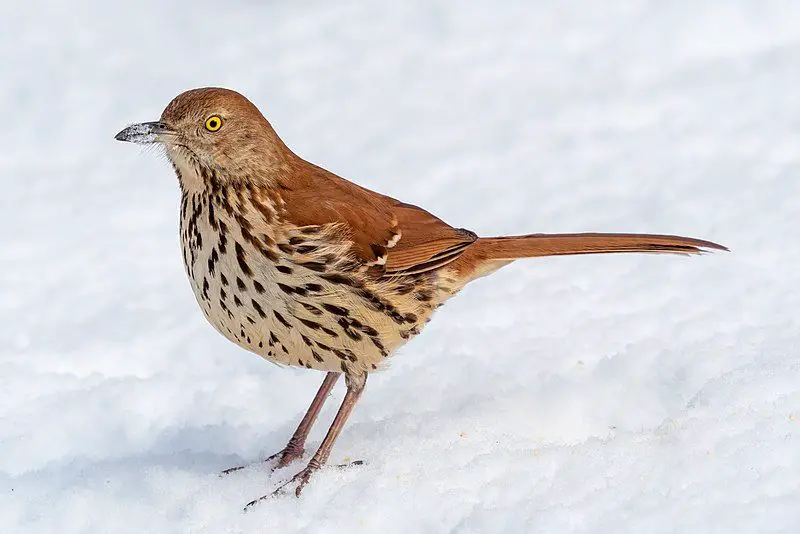
The brown thrasher is a bird that belongs to the family Mimidae. This family includes other birds like the New World catbirds and mockingbirds.
It is important to note that sometimes, people mistakenly refer to the brown thrasher as the brown thrush or fox-colored thrush. The brown thrasher has a distinct appearance with its brown feathers.
Its coloration resembles a fox, sometimes called the fox-colored thrush.
However, it is essential to remember that it is not a thrush but a member of the Mimidae family. As a member of the Mimidae family, the brown thrasher shares similarities with other birds in this group.
Mimidae birds are known for their ability to mimic the sounds and songs of other birds. While the brown thrasher is not as famous for its mimicry skills as mockingbirds, it can still imitate some sounds. The brown thrasher is primarily found in North America.
Its range extends from southern Canada to central Mexico. It prefers habitats such as dense shrubs, woodland edges, and overgrown fields. These areas provide the birds with plenty of cover and food sources. In terms of size, the brown thrasher is medium-sized.
| Kingdom | Animalia |
| Phylum | Chordata |
| Clade | Dinosauria |
| Class | Aves |
| Order | Passeriformes |
| Family | Mimidae |
| Genus | Toxostoma |
| Species | T. rufum |
45. Winter Wren
The winter wren is a tiny bird found in North America. It belongs to the Troglodytidae family, mainly consisting of wrens in the New World.
In the past, it was considered the same species as the Pacific wren in western North America and the Eurasian wren in Eurasia.
However, it is now recognized as a distinct species called the winter wren. The winter wren is known for its small size and is one of the smallest birds in North America.
It can be found in coniferous forests, dominated by cone-bearing trees like pine, spruce, and fir. Its habitat ranges from British Columbia in Canada to the Atlantic Ocean. This little bird is known for its distinctive behavior and appearance.
It has a compact body with short wings and a short tail, making it well-suited for navigating through dense forest vegetation.
Its plumage is usually dark brown with fine streaks on its back and a light-colored throat and belly. During the breeding season, which generally occurs in the spring and summer, the winter wren builds its nest in tree cavities or among tree roots.
The male wren is known for its beautiful and melodious song.
| Kingdom | Animalia |
| Phylum | Chordata |
| Clade | Dinosauria |
| Class | Aves |
| Order | Passeriformes |
| Family | Troglodytidae |
| Genus | Troglodytes |
| Species | T. hiemalis |
46. Common Grackle
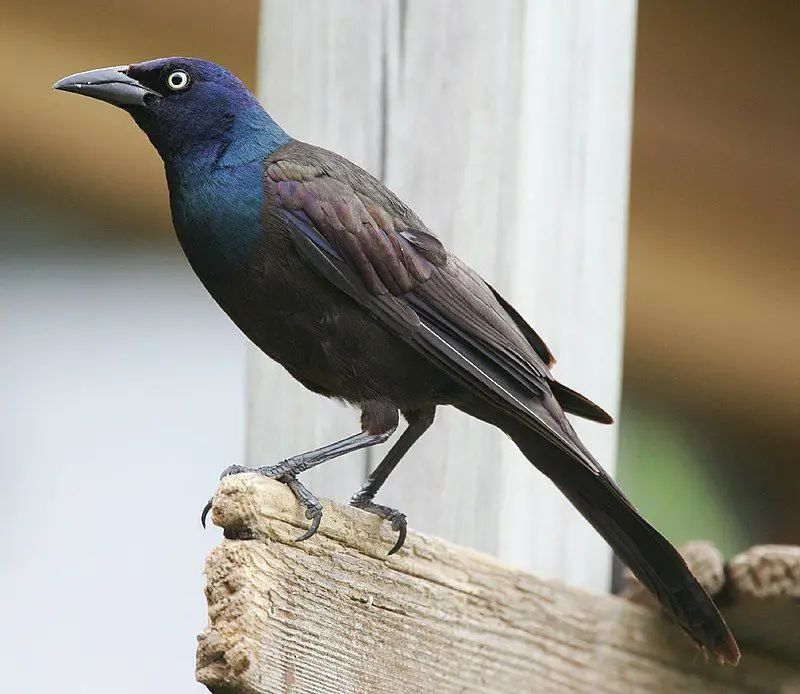
The common grackle is a bird found in many parts of North America. It was first identified and described by a scientist named Carl Linnaeus in 1758. This bird belongs to a family of birds known as icterids.
One exciting thing about the common grackle is its three different subspecies. This means there are slight variations in appearance among the various groups of these birds. When an adult common grackle is fully grown, it has certain distinct features.
For example, it has a long bill that is dark in color. The bird uses this bill to catch and eat its food. The common grackle also has pale yellow eyes, which add to its unique appearance. Another noticeable characteristic of the adult common grackle is its long tail.
This tail is an essential part of the bird’s body, as it helps with balance and maneuverability during flight. It is worth noting that the common grackle is a reasonably large bird compared to some other species.
Its size contributes to its visibility and makes it easier to spot in its natural habitat. The common grackle is an exciting bird species with distinct physical traits. It’s large numbers across the North.
| Kingdom | Animalia |
| Phylum | Chordata |
| Clade | Dinosauria |
| Class | Aves |
| Order | Passeriformes |
| Family | Icteridae |
| Genus | Quiscalus |
| Species | Q. quiscula |
47. Bald Eagle
The bald eagle is a type of bird that lives in North America. It is considered a bird of prey, which means it hunts and feeds on other animals. This majestic bird is also known as a sea eagle. There are two known subspecies of the bald eagle.
Subspecies are variations of a species that have slightly different characteristics but can still interbreed. These subspecies of the bald eagle might have some differences in appearance or behavior. The bald eagle is closely related to another bird called the white-tailed eagle.
These two birds form a species pair, which means they are similar and occupy similar ecological niches.
The white-tailed eagle is found in the Palearctic region, which includes Europe, Asia, and Africa. Occupying the same niche means that the bald and white-tailed eagles have similar roles in their respective ecosystems.
They both have adaptations that help them survive and thrive in their environments.
They might compete for similar food sources or have similar hunting strategies. In the Palearctic region, where the white-tailed eagle is found, it fulfills an ecological role similar to that of the bald eagle in North America.
This means both species have evolved to fill their habitats’ specific niche or role.
| Kingdom | Animalia |
| Phylum | Chordata |
| Clade | Dinosauria |
| Class | Aves |
| Order | Accipitriformes |
| Family | Accipitridae |
| Genus | Haliaeetus |
| Species | H. leucocephalus |
Conclusion
Winter birds are vital in Indiana’s ecosystem, providing color, motion, and vocalization to an otherwise quiet and serene winter landscape.
They exhibit remarkable adaptations to survive harsh weather conditions, such as migration, altered diets, and thermoregulation techniques. Observing and appreciating these winter birds can bring joy and a sense of connection to nature during the colder months.
However, providing them with suitable habitats and food sources is crucial to ensure their well-being and continued presence in Indiana.
By implementing conservation efforts and promoting awareness, we can contribute to the conservation of these winter birds and enhance the diversity and resilience of Indiana’s avian community.